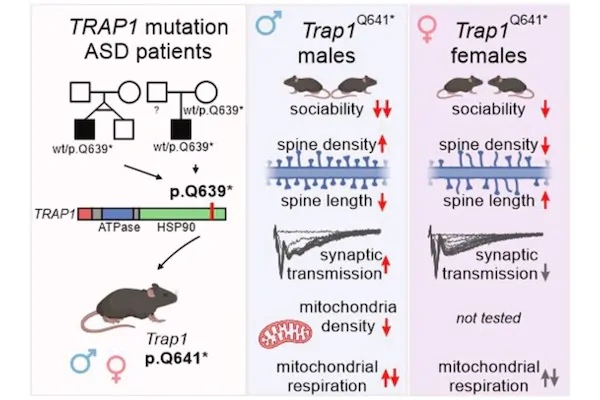Our publication in the journal “EMBO Molecular Medicine”

Ten teams, including researchers from the Molecular Neurobiology Laboratory of the UW Department of Biology, conducted a study that confirmed the potential role of mitochondria in the aetiology of autism. A publication on this topic appeared in the journal EMBO Molecular Medicine.
The article, entitled “Mutation in the mitochondrial chaperone TRAP1 leads to autism with more severe symptoms in males”, is the result of collaboration between scientists from the University of Warsaw, the Warsaw Medical University (WUM), the International Institute of Molecular and Cell Biology (IIMCB) and the M. Nencki Institute of Experimental Biology of the Polish Academy of Sciences.
Autism spectrum disorders (ASD) are more common in males than females and have a genetic basis, although they usually result from the interaction of multiple genes. However, there are cases where a single genetic mutation is the direct cause of ASD. Researchers from the Medical University of Warsaw (Prof Rafal Ploski and Dr Malgorzata Rydzanicz) have identified a new mutation in a patient with ASD who has a healthy twin brother (monozygotic), indicating that the mutation originated de novo and is not present in the parents. The mutation described relates to the TRAP1 gene, which encodes the mitochondrial protein of the HSP90 chaperonin family. The same mutation was independently discovered in another Polish ASD patient, this time inherited from a healthy mother.
To better understand the impact of the identified mutation on the organism, it was necessary to create a research model. Genetically modified mice were constructed by researchers at the International Institute of Molecular and Cellular Biology (group of Prof Andrzej Dziembowski and the service labs of the IIMCB). Subsequently, studies conducted at the Nencki Institute confirmed the impaired social behaviour of the mice, especially the males, proving that a mutation in the TRAP1 gene can indeed lead to ASD. Further research by scientists at the University of Warsaw (a group led by UW professor Magdalena Dziembowska) has enabled an in-depth understanding of the effects of this mutation. Mice with the TRAP1 mutation had altered morphology and function of synapses, which affects signal transduction in neurons. In addition, a reduced number of synaptic mitochondria and changes in mitochondrial metabolism in brain cells were observed.
These findings are the first evidence of a link between impaired mitochondrial protein homeostasis caused by a mutation in the TRAP1 gene and ASD. They also point to a role for mitochondria in the aetiology of ASD and suggest that further research into the regulation of mitochondrial metabolism may contribute to the development of more effective therapies.
At the UW Department of Biology, the work was conducted in our laboratory. Involved in the construction of the genetically modified mouse was Ph. Ewa Borsuk from the Department of Embryology.
The research is currently being continued under a grant NCN OPUS 26 entitled. ‘Dietary intervention in the treatment of genetically mediated autism in a mouse model’ led by Dr Bozena Kuźniewska.